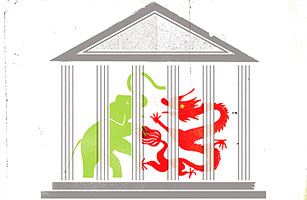
If I have to endure another corporate executive blindly praising China and reflexively trashing India, I might actually gag. I'm often trapped in conversations with suits that follow the same, excruciating pattern. First, they swoon over China's stellar roadways and airports, the superior wisdom of Beijing's policy mandarins and the clinical efficiency of its authoritarian regime. Then they turn 180 degrees to rail against the feebleness of India's infrastructure, the ineptitude of New Delhi's bureaucrats and the convoluted course of Indian democratic politics. How, they ask, can India ever catch up?
When comparing India and China, most economists and business folk simply look at the wrong things. Beijing's bureaucrats may be better at building roads, but government dictates and human-rights abuses won't ensure the country's economic success. The past half-century of Asian economic history tells us that sustained development ultimately depends on entrepreneurship, a strong private sector, rule of law and political openness. India, not China, possesses these crucial building blocks of economic progress. And that is why India will overtake China as the world's premier emerging economy.
When I make this argument, I usually get bewildered stares — probably the same response you're having right now. Yes, I can see why many people believe India is stuck sucking fumes behind China's great industrial machine. The Indian economy hasn't been growing as quickly as China's, nor has its industry imprinted as deep a mark on the global economy. India has more than twice as many people trapped in desperate poverty, while its fractious democracy entangles policymaking in long-winded debates and ideological tussles unthinkable within China's autocratic government. Beijing and Shanghai are connected by high-speed trains; their thoroughfares are lined with modern office towers. In New Delhi and Mumbai, the dusty lanes remain lined with barefoot beggars and cluttered with soot-belching motorized rickshaws.
But to discover which nation will win out over the long haul, we need to dig past surface appearances, down into the guts of the two economies, to learn how they tick. China's economy appears lovely on the outside but is rotten at the core, like a brightly polished Ferrari with the innards of a Pinto. India's growth engine may occasionally get smeared with manure and lost in detours, but check under the hood, and you'll find it is much more powerful than it looks — more powerful, in fact, than China's.
Part of the reason is simple mathematics. Since the Chinese economy is more than three times the size of India's, the Middle Kingdom's growth rate will inevitably slow, allowing India to close the gap. For a developing economy, China is aging rapidly because of the distortions caused by its controversial one-child policy, giving India a demographic advantage in generating future growth. Much more important, and contrary to what many believe, India possesses a superior economic model to China's — sturdier, healthier and better equipped to maintain rapid progress over the long term.
That's because India's economy has balanced sources of growth. Strong domestic demand drives India's GDP, offering the economy protection from external shocks. China has no such cushion. Its economy is overly dependent on investment and exports. Economists believe China needs to encourage more domestic private consumption — to "rebalance" — to promote sustainable economic growth. In other words, China has to become more Indian. That became obvious during the Great Recession. India charged through the downturn because the resilient Indian consumer propelled the economy forward. When the financial crisis hit China, however, Beijing was forced to unleash a tsunami of government stimulus and credit from state-controlled banks to keep growth going. Even though the world's economists lauded the effectiveness of China's recession-fighting methods, these were, in fact, a sign of the economy's frailties.